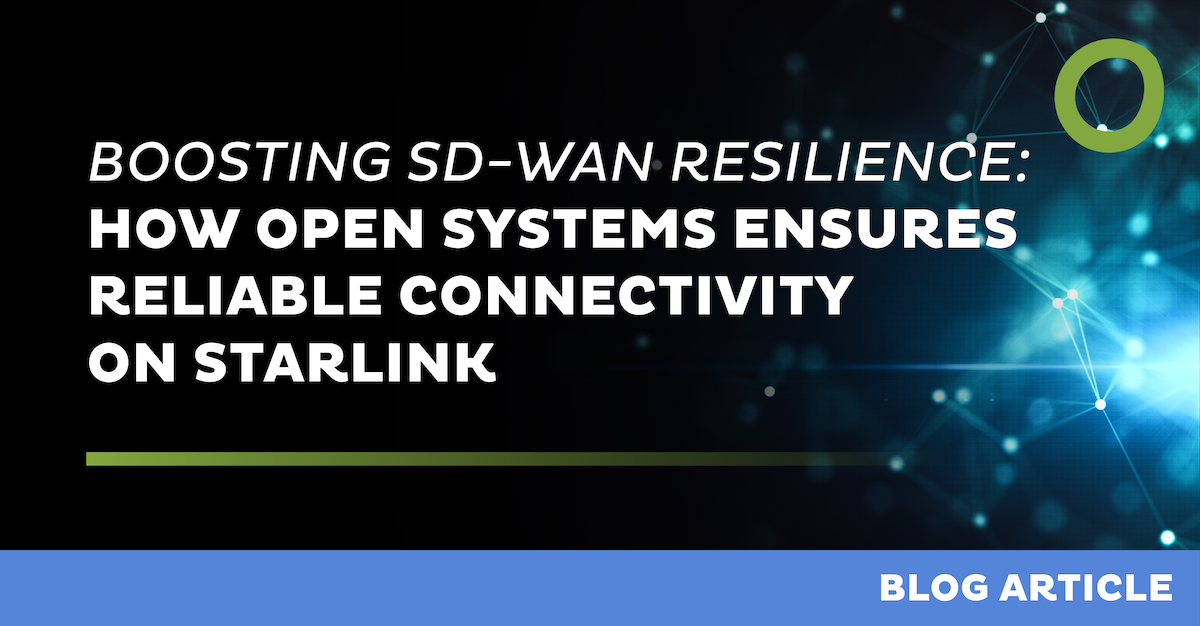
Boosting SD-WAN Resilience: How Open Systems Ensures Reliable Connectivity on Starlink


The new era of enterprise connectivity
Enterprise connectivity has changed dramatically. Where MPLS was once the standard for reliable networking, organizations now expect more flexible, cost-effective, and resilient solutions. SD-WAN has emerged as the answer, combining broadband, fiber, 5G, and satellite links into one intelligent, managed network fabric.
One of the biggest trends today is the adoption of Starlink, SpaceX’s low-earth orbit (LEO) satellite service. Unlike traditional satellite connections, which are slow and high-latency, Starlink provides high-speed, low-latency internet almost anywhere on the planet. For enterprises, that means:
- Redundancy where nothing else exists – remote sites, maritime, mining, or rural operations now have an emergency link if their main lines fail.
- An alternative to expensive GEO satellite – with better performance for business-critical applications.
- Faster disaster recovery and business continuity – when terrestrial networks are unavailable or disrupted.
Reports from industry analysts like Gartner and coverage in outlets like Forbes confirm the accelerating role of LEO satellite in enterprise networking strategies.
The challenge: Starlink’s unique network behavior
While Starlink opens new doors for connectivity, it also behaves differently than traditional networks. A key challenge is the way Starlink handles public IP addresses.
Here’s the issue:
- Starlink assigns public IP addresses dynamically, with very short lease times.
- If the service detects that a connection is “dead,” it quickly reassigns the IP address, sometimes in just a few seconds.
- This can confuse VPN or SD-WAN tunnels, which may continue trying to connect to an old IP address that no longer exists.
The result? Temporary loss of connectivity, which can mean frozen video calls, interrupted remote access, or application downtime. This behavior has been noted by IT leaders and networking communities alike, who have flagged recurring VPN issues on Starlink links.
The Open Systems solution: resilience without effort
At Open Systems, we see it as our mission to take the complexity and risk out of global connectivity. When our engineers identified this Starlink-specific issue, we didn’t wait for customers to raise tickets or force them to upgrade devices.
Instead, we built and rolled out automatic remediation that automatically re-establishes the tunnels when we detect that Starlink public IP addresses have rotated.
For our customers, this means:
- Less disruption – reduced impact when Starlink changes behavior in the background.
- No manual updates – Open Systems manages the SD-WAN platform end-to-end, including monitoring, upgrades, and fixes.
- Always current – every customer benefits instantly, without scheduling maintenance or having to roll out patches by themselves.
And importantly: no action is required on their side. Our managed service model ensures you’re always protected, 24×7.
The business impact
This enhancement reflects the broader promise of Open Systems: simplifying complexity so enterprises can focus on growth, not troubleshooting networks.
With this improvement in place, organizations using Starlink as part of their SD-WAN strategy can expect:
- Higher availability and less disruption
- Better user experiences for remote teams and critical applications
- Greater confidence in using satellite connectivity as a true enterprise option
As enterprises expand into more distributed, hybrid, and remote environments, innovations like this keep your network future-ready, resilient, and secure – without adding to your IT team’s workload.
Leave Complexity
Behind
To learn how Open Systems SASE Experience can benefit your organization, talk to a specialist today.
Contact Us



